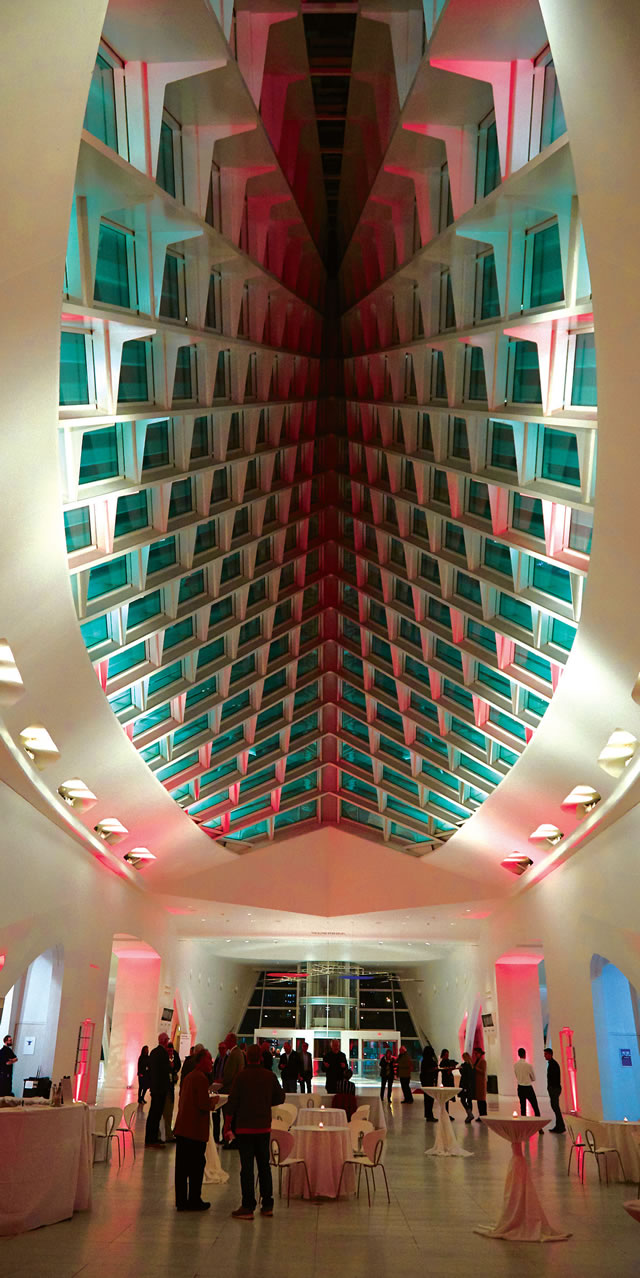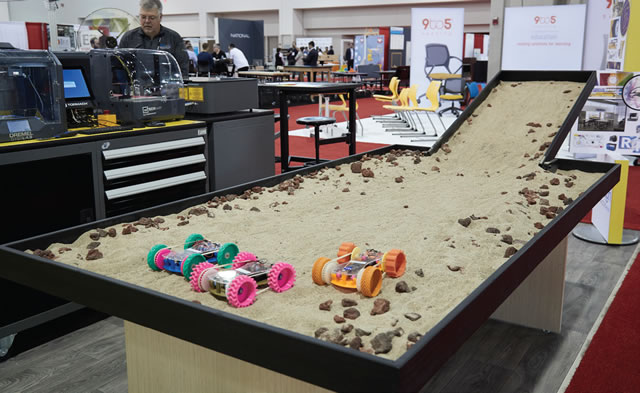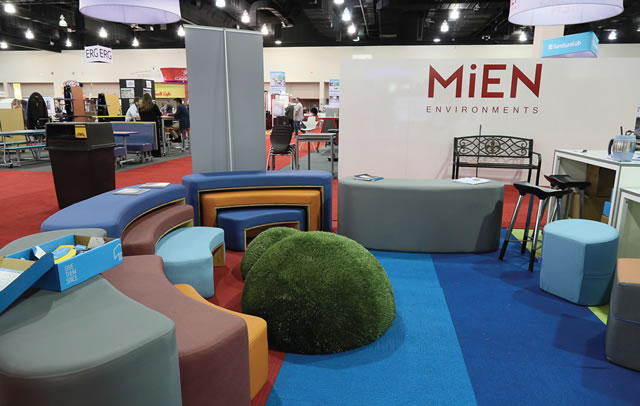Elevating the Discussion On Transforming Education
Expert teams of designers, architects and administrators managing and renovating educational facilities
gathered at EDspaces 2019 in Milwaukee last month, elevating
the discussion on transforming education. Attendees understand
that today’s students are multitasking, tech-enriched collaborators
with a variety of learning styles. They also understand the value
of education for their own teams, as they took advantage of conference
educational offerings that included plenary and education
sessions, interactive classroom designs and tours of new K–12 and
higher education facilities.

Photo credit: EDmarket.org
AIA - CAE Reception
Spaces4Learning: How did 2019 compare to past
years? What are growth trends compared to five years ago?
Jim McGarry: EDspaces has been named one of the
fastest growing tradeshows in the United States for the last three
years running in several different categories. Attendance this year
is about 10 percent higher compared to last year. More education
institutions are bringing their teams to EDspaces so they can
explore their facilities’ challenges and discover approaches to the
pedagogical and technological needs as they design and create
spaces to better serve future student populations.
S4L: What were some of your highlights and takeaways
from this year’s convention?
McGarry: Every year there are new ideas at EDspaces that
enhance attendee experience and expand the scope of learning
and fun. Milwaukee was no exception.
One of the most anticipated programs was the designed classrooms
program, where each year A&D firms, dealers and manufacturers
compete to design and outfit each of the classrooms
where professional development happens. Attendees get the opportunity
to visualize and experience new classroom design theory
as well as some of the most innovative products and technology
available. This year, we held an open house for attendees to more
thoroughly explore the classrooms and chat with the designers
and manufacturers about how concepts and furnishings might
work in their projects.
Since the classroom program has been well received, we expanded
the program to feature cafeteria seating and furniture on the
exhibit floor. Since every school and college campus has a designated
food service area, we thought the EDspaces 2,000+ participants
would appreciate being served lunch in designed seating areas. This
gave teams a hands-on opportunity to consider a variety of possibilities
available when planning for a new cafeteria or dining hall.
S4L: EDspaces has seen some tremendous changes over
the last few years, evolving from a distributor kind of show to one addressing the broader education sector. Can you talk
about the changes that were put into this year’s program —
the networking opportunities, the sessions, the exhibit hall?
McGarry: Exhibitors rank seeing customers as critical to
their success, and delivering outstanding ROI for our exhibitors
is a high priority for us as the organizer of this international
event. The growth we’ve seen in school participation is a result
of new marketing efforts and our unique scholarship program
that helps fund travel and registration for those districts with
planned construction and renovation projects. Another interesting
trend is that even with the steady growth in school, architect
and designer participation, EDspaces continues to be the only
home for distributor education. We continued our commitment
to the distributor community by hosting the pre-conference Educational
Distribution Symposium, sponsored by Spaces4Learning.
This education program inspired top management and sales
professionals to reach new levels of service to the educational
products marketplace and to work in partnership with their
vendors and customers.
S4L: Will you talk about the themes of this year’s conference
and how they were predicated on changes in the
market — sustainability, STEM and STEAM education,
changes in pedagogy, new demands on security, etc.?
McGarry: EDspaces is focused on the intersection of
technology, space and pedagogy, reinforcing that a successful
educational environment cannot be designed without exploring
these issues in tandem. Our volunteer program committee
identifies program areas that are timely to challenges facing
school districts and the A&D community. This year, the focus
was on active learning environments, collaboration, community
engagement, equity, health and wellness, integrating furniture
and technology, makerspaces/STEM labs, pedagogy and space
and safety and security.

Photo credit: EDmarket.org
Makerspace and hands-on activity lab on display in the
EDspaces exhibit hall.
EDspaces is always adjusting and changing to address the
unique challenges in the education arena, so this year there were
new program offerings that included a pre-conference Learning
Lab, STEM Innovation Tour, exploring how school districts of diverse
backgrounds promote STEM and STEAM learner-centered
education.
Sustainability and wellness of students and faculty continue to
be a focus, so we created a lounge on the exhibit floor where a series
of 30-minute professional development sessions highlighted these
important aspects of educational design. It also housed a gallery
of ideas from Knowledge Partner USGBC and sponsor Interface
to highlight concepts and examples of wellness and sustainability.
S4L: Technology is playing an
ever more ubiquitous role in all
aspects of education, including
facilities, learning space design
and teaching and learning itself.
How large a part of this year’s
conference was technology, and
how do you see it expanding in
the future?
McGarry: Yes, we see technology
playing a larger role, as it is
thoroughly embedded into every
aspect of education. That’s why
we created the new Knowledge
Partnerships with AVIXA, the Audiovisual
and Integrated Experience
Association, and ATLIS, the Association
of Technology Leaders in
Independent Schools. The number
of vendors showing integrated tech
products is growing as more schools
bring their tech experts to EDspaces.
We even had a VR specialty
space to highlight its use in design.
We definitely see an expanding role
of technology in the future.
We’ve integrated new technology
into our own conference management,
using artificial intelligence to connect
attendees with relevant education
sessions, peers and products through
the EDspaces app. We launched it
via our registration and mobile app,
providing suggested connections to
participants, making the EDspaces
experience more meaningful.

Photo credit: EDmarket.org
Scenes from the EDspaces 2019 exhibit hall.
S4L: A lot of the focus on
this year’s show was K–12. Do
you see it growing to include an
equal focus on higher education
as well? Can you discuss that?
McGarry: About 20 percent
of the education attendees were
from higher ed institutions. This is
growing every year. We are encouraging
their participation through
the types of vendors on the exhibit
floor that they can see nowhere else
as well as the specific higher ed
sessions and tours of cutting-edge
buildings on higher-ed campuses.
S4L: What do you see as the
major trends you’ll be spotlighting
at your conferences over the next few years? And do you have any new types
of events you’ll be hosting?
McGarry: In Charlotte in 2020 we have plans to highlight a few new areas. We’re
excited to continue to expand the technology presence and look to create an area that
will showcase what’s coming next. We also know that there’s a growing need to create
spaces for students with special needs, so we are going to build out an area to allow a
conversation about designing for these types of areas. And lastly, as the interior designer
attendees grow, we are going to focus more on the finishes and materials they can specify
that work best in the high-use education environments.
This article originally appeared in the November/December 2019 issue of Spaces4Learning.